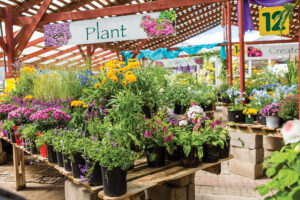 A trip to the garden center is similar to a trip to the candy store. There are so many wonderful treats to tempt the senses, from fanciful colors to fantastic forms to appealing fragrances, and occasionally some you want to rub against your face.
A trip to the garden center is similar to a trip to the candy store. There are so many wonderful treats to tempt the senses, from fanciful colors to fantastic forms to appealing fragrances, and occasionally some you want to rub against your face.
While the onset of spring can be defined when the first bags of mulch arrive at the gas station, a true gardener can be defined by how far he/she is willing to travel to get a particular plant. Even with Amazon and Google, and every other internet interaction, searching out that plant is not something left to the keyboard.
Over the years, I’ve gone from Cairo to Rockford, Danville to Quincy and all points in between to find some plants for the garden or decorative pots for the patio. While garden centers are the preferred locations, the big box stores will sometimes surprise you with one of those plants you’ve been hunting for years, and at a price that makes your jaw drop. So, you grab the best one, and then call all your friends.
That best plant sometimes may not be as “best” as you’d like. But, how many folks do you know that went from gangly teenager to a beauty, either in the feminine or masculine sense? With a little TLC, most plants will respond, especially annuals which put everything into their first and only year.
Still, it doesn’t hurt to try to get the best plant. After all, there may be hundreds to choose from, and why not take the best?
For trees, you want to concentrate on the leader the central trunk of the tree. It should be straight and go all the way to the top. Trees with a split leader should be avoided, as this double or triple trunk will usually split about 20 to 30 years down the road, just when the tree is providing the needed shade. This is different from clump trees with more than one plant in the cluster.
Fruit trees are a different ball of wax. Having the leader removed keeps the plant smaller and easier to manage, not to mention harvest.
The more branches the better. For trees, those lower branches provide needed energy and help to make a thicker trunk.
For annual flowers and vegetables, the more compact the plant, the better. Think of one of those stout, short football players instead of a lanky basketball star or Twiggy. Plants grown under cooler temperatures thrive better when we put them in the soil.
And ideally, and this is the gasp-inducing statement, you don’t want any flowers or vegetables forming. Instead of rooting and adapting, they concentrate the plant’s energy on producing seeds. Sure, you want to know what color the flowers are; just pinch them off immediately before planting, no matter how hard it is.
Realize most perennials will take a couple of years to develop into a mature form. Avoid plants with lots of roots coming out of the pots. The plant’s color should be a rich grass to dark green; avoid yellowish green plants unless that’s the nature of the plant.
This spring has nipped many plants, and some of the leaves aren’t that great. Some plants may have been cut back severely, while others may have perfect new growth covering damage below. Concentrate on what looks great.
And if you buy too many plants, donate them to friends instead of trying to crowd them in your yard. Plants need room to develop. Or just dig up more of the yard and create more gardens.









